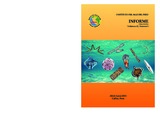Por favor, use este identificador para citar o enlazar este ítem:
https://hdl.handle.net/20.500.12958/2976| Título : | Pesca exploratoria y experimental con red de cerco artesanal en la Región Tumbes.2005 |
| Otros títulos : | Exploratory fishing and experimental traditional purse seiner in the Tumbes Region, 2005 |
| Autor : | Salazar Céspedes, Carlos Martín Ganoza Chozo, Francisco Alarcón Vélez, Julio Iriarte Ahon, Federico Chacón Nieto, Germán Vásquez, Carlos Román, Armando Calderón Martell, Jairo |
| Palabras clave : | Pesca Exploratoria;Pesca Experimental;Red De Cerco;Pesca Artesanal;Artes De Pesca |
| Fecha de publicación : | 2015 |
| Editorial : | Callao |
| Citación : | Inf Inst Mar Perú 42(2), 2015. p. 242-261 |
| Citación : | Informe IMARPE;Vol. 42, N° 2 |
| Resumen : | Se evaluó la utilización de la malla de 50 mm (2”) en redes de cerco artesanal de la Región Tumbes en una pesquería multiespecífica. Se trabajó con una red control de tamaño de malla de 38 mm (1,5”) y la red experimental de 50 mm (2,0”), con un porcentaje de embande de 0,65 y 0,77, respectivamente. Se determinó diferencia entre las curvas de profundidad de calado del cuerpo central de las redes (tc= 46,670, t*= 1,98, p= 0) la red experimental tuvo mayor profundidad de velado; entre las curvas de velocidad de caída del cuerpo central de las redes, hubo diferencia significativa (tc= 7,790, t*= 1,98, p = 0,000), debido al mayor lastre y filtrado de las mallas
de la red experimental. El coeficiente abertura horizontal (μ1) de las mallas en la franja superior durante el máximo velado de la red y el gareteo fue en las mallas del cabecero o copo, parte central y ultimo cuerpo de la red, en promedio 0,71; 0,74 y 0,73 respectivamente; (valores cercanos al coeficiente de armado ideal para
el escape de ciertos peces fusiformes). El promedio de μ1 obtenidos en la región de las mallas centrales en el cabecero, centro y ultimo cuerpo de la red fue 0,85; 0,85 y 0,84 respectivamente; lo que indicó una mayor abertura horizontal de las mallas por encima del valor del coeficiente de armado que no permitiría el escape de los peces. Se concluyó que por la condición de las mallas de la red de cerco experimental (tamaño de malla 50 mm) no es óptima para gran parte de la estructura de la red, esto no permitiría la selectividad por tamaños. ABSTRACT: In this paper, the use of mesh 50 mm (2”) in artisanal purse seiner of the Tumbes Region in a multispecies fishery was assessed. We worked with a control purse seiner of mesh size of 38 mm (1.5”) and the experimental fishing net of 50mm (2.0”) with a percentage of hanging ratio of 0.65 and 0.77; respectively. Operational assessment of the purse seine was observed that there was a difference between the curves of setting depth of the central body of the net (tc = 46.670, t* = 1.98, p = 0), the experimental net had a more setting depth. Likewise between the curves drop speed of the central body of the purse seiners, there was a significant difference (tc = 7.790, t* = 1.98, p = 0) due to greater weight and filtering mesh of the experimental net. The horizontal opening (μ1) of the meshes in the upper band for the maximum setting depth and purse line recovering, the meshes of cod end, middle part and last body of the net, was on average (μ1) 0.71, 0.74 and 0.73 respectively; (values close to the hanging coefficient ideal for escaping of fusiform fishes). The average (μ1) obtained in the region of the central meshes in the cod end, middle part and last body of the net was 0.85, 0.85 and 0.84 respectively; which indicated a greater horizontal opening of the mesh above the hanging coefficient would not allow the escape of fishes. It was concluded that the mesh condition of experimental net (mesh size 50 mm) is not optimal for large part of the net structure; this would not allow fish selectivity sizes. |
| Descripción : | Informe IMARPE;Vol. 42, N° 2, 2015. p. 242-261 |
| URI : | https://hdl.handle.net/20.500.12958/2976 |
| Aparece en las colecciones: | Informe vol. 42(2) 2015 |
Ficheros en este ítem:
| Fichero | Descripción | Tamaño | Formato | |
|---|---|---|---|---|
| INFORME VOL 42 (2)-10.pdf | 20,74 MB | Adobe PDF |  Visualizar/Abrir |
Este ítem está sujeto a una licencia Creative Commons Licencia Creative Commons

